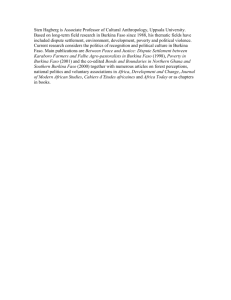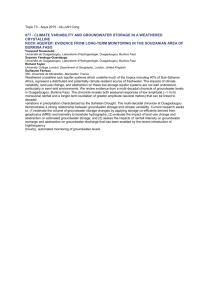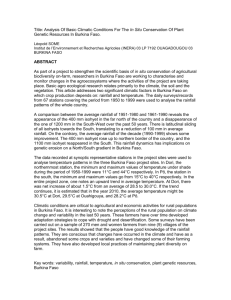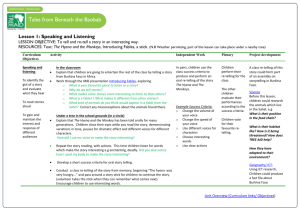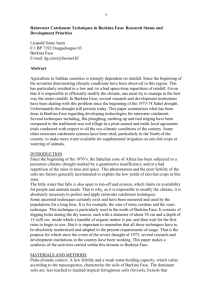Ouagadougou, Burkina Faso, 18 July 2013
advertisement
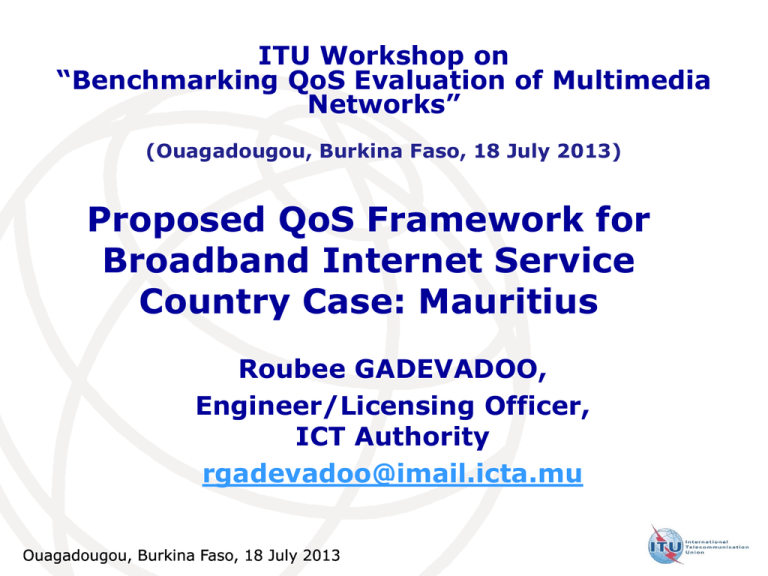
ITU Workshop on “Benchmarking QoS Evaluation of Multimedia Networks” (Ouagadougou, Burkina Faso, 18 July 2013) Proposed QoS Framework for Broadband Internet Service Country Case: Mauritius Roubee GADEVADOO, Engineer/Licensing Officer, ICT Authority rgadevadoo@imail.icta.mu Ouagadougou, Burkina Faso, 18 July 2013 Presentation Outline Background Scope of the QoS Framework for Broadband Internet Quarterly Performance Report Independent Testing Facility Customer Service Obligations Conclusion and Recommendations Ouagadougou, Burkina Faso, 18 July 2013 2 Background Broadband Internet penetration rate in Mauritius has increased significantly over the past years. Currently about 75% of Internet subscribers have a broadband connection Ouagadougou, Burkina Faso, 18 July 2013 Background Growth in Broadband Internet subscriptions: Both on fixed and mobile networks Ouagadougou, Burkina Faso, 18 July 2013 Background Enabling Factors: enabling policies ; Deployment and enhancement of broadband networks by operators; higher speed needs from consumers One of the salient features of the National Broadband Policy 2012-2020 for the Republic of Mauritius, is to ensure the quality of service of broadband services from ‘best effort‘ to ‘minimum guaranteed‘ levels Ouagadougou, Burkina Faso, 18 July 2013 Background In line with its statutory function, the ICT Authority is mandated to take appropriate measures to ensure the quality of service of Broadband Internet services Proposal: QoS Framework for Broadband Internet Service Ouagadougou, Burkina Faso, 18 July 2013 Scope of the QoS Framework for Broadband Internet Current Situation Broadband Internet Service is sold by ISPs on an ‘up-to’ basis Disparity between the speed advertised by ISPs and the actual speed achieved by subscribers Lack of adequate information-subscribers cannot make informed choices when entering into contracts with ISPs Ouagadougou, Burkina Faso, 18 July 2013 Scope of the QoS Framework for Broadband Internet Main Provisions of the QoS Framework Obligations on ISPs to submit a quarterly Performance Report Implementation of an Independent Speed Testing Facility by regulator Customer Service obligations on ISPs Provisions enforced in appropriate Regulatory Instrument (e.g. Directive) Ouagadougou, Burkina Faso, 18 July 2013 Quarterly Performance Report Set of QoS Parameters defined for the Broadband Internet Service Target values set Measurement Methodology defined Submission by ISPs of Performance Report based on the above Performance of ISPs to be published by the regulator Ouagadougou, Burkina Faso, 18 July 2013 Quarterly Performance Report QoS Parameters for Broadband Internet Service Technical Parameters Non-Technical Parameters Service Availability Service Activation Time Network Latency - National - International Fault Repair Time Packet Loss Complaint Resolution Time Transmission Speed Bill Correctness Complaint Bandwidth Utilisation Passive Data Collection: Based on analysis of flow of traffic over the network Ouagadougou, Burkina Faso, 18 July 2013 Quarterly Performance Report Example: QoS Parameters for Broadband Internet Service Service Availability Definition: Ratio of total time during which the Access Network, Core Network and the Local and International Connections are simultaneously available to the subscriber in a given period of time Measurement : As per ETSI ES 202 765-4 (2010-10) Target : Greater than 99.95% Ouagadougou, Burkina Faso, 18 July 2013 Quarterly Performance Report Example: QoS Parameters for Broadband Internet Service Network Latency Definition: Indication of the round-trip delay in the network Measurement : Ping tests to be done from a user test point to a server located within the national network (e.g. at IXP). For international network latency, server located at a designated international PoP. Target: less than 300ms (int.) Ouagadougou, Burkina Faso, 18 July 2013 Quarterly Performance Report Example: QoS Parameters for Broadband Internet Service Data Transmission Speed Definition: Data transmission rate that is achieved separately for downloading and uploading specified test files between a remote web site and a user’s computer Measurement: Upload and download speeds obtained from the measurements recorded in SNMP counters that are maintained by the router(s) located within the core network of the ISP. Target: Within the limits of Typical Speed Range Ouagadougou, Burkina Faso, 18 July 2013 Independent Testing Facility Independent Speed Testing facility set up and controlled by the regulator Ouagadougou, Burkina Faso, 18 July 2013 Independent Testing Facility Tests done in two domains: national and international -For national: Test server directly connected to the Internet Exchange Point -For international: Test server connected at international PoP Consumer centric: End users carry out test from their PC Set up may be used as a monitoring tool by the regulator Ouagadougou, Burkina Faso, 18 July 2013 Customer Service Obligations Set of Customer Service Obligations: ISPs to state the Typical Speed Range of Internet package in all advertisements ISPs to provide information such as Contention Ratio, Access Line Speed and Capping (if any) ISPs to provide trial period to subscribers to verify whether their broadband connection perform within limits of Typical Speed Range ISPs to spell out their QoS-related complaints management process Ouagadougou, Burkina Faso, 18 July 2013 Conclusions and Recommendations The QoS framework serves 2 main purposes: Consumer Protection and Monitoring QoS framework should achieve the following: Ensure that broadband Internet subscribers can make informed choice of their Internet package based on their individual needs Ensure that broadband Internet subscribers have access to comparative information to be able to choose their preferred service provider Ensure that broadband subscribers are aware of the performance and limitations of the Internet package they are subscribed to Encourage ISPs to market only Internet package that they can physically provide Ensure that the performance of Broadband Internet service be monitored in a fair and independent way Ouagadougou, Burkina Faso, 18 July 2013 Conclusions and Recommendations Way Forward Consultation with ISPs on the provisions of the QoS framework Agree on the Technical set-up and the QoS software Enforce the provisions through appropriate regulatory instruments (Regulations/Directive) Ouagadougou, Burkina Faso, 18 July 2013
